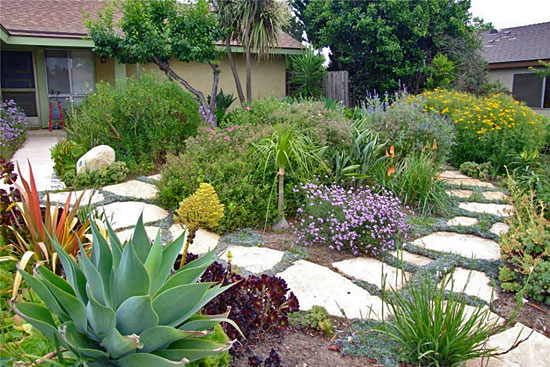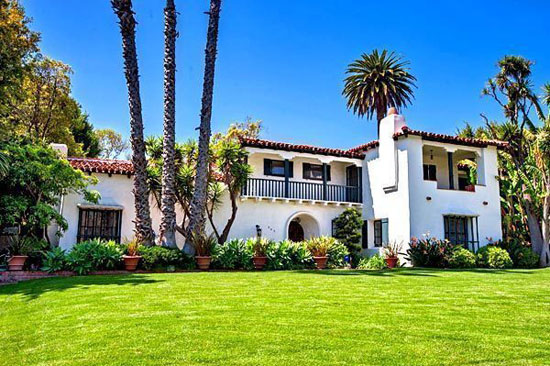Start saying so long to the lawns of Southern California.
As the realities of climate change and drought have begun to sink in statewide, local figures indicate that homeowners have finally begun—gradually—to let go of their grass.
Amid new state conservation mandates and growing financial incentives, thousands of lawns and millions of square feet of green turf have disappeared during the last three years in Los Angeles County, much of it during the past year of record-low rainfall.
The reason? Outdoor irrigation is now consuming an estimated 50 percent of the average water bill.
This week, in an unprecedented action, the State Water Resources Control Board made it a statewide criminal infraction to waste water, particularly on landscape irrigation. Meanwhile, cities throughout the county have upped turf removal incentives encouraging homeowners to go drought-tolerant, at least in their front yards.
The moves have accelerated a trend that is already approaching critical mass in Southern California, even as they reorder a landscape that has long characterized the region.
“It’s slow, but things are really changing,” says Matthew Lyons, director of planning and water conservation for the Long Beach Water Department.
“Three of the last four years have been dry and this last winter was catastrophic. There’s just not a future here for grass lawns.”
Acceptance of that reality hasn’t been easy.
“People have had a hard time letting go of their beautiful green sward,” says Lili Singer, director of special projects and adult education for the Sun Valley-based Theodore Payne Foundation, a native plant organization that has done a land-office business this year helping county homeowners rethink their landscapes.
“Everybody on the block has the same setback and the same yard and people don’t want to be the oddball,” said Singer. “But there’s also this thing about having an estate.”
“It’s an enormously emotional thing,” agrees Stephanie Pincetl, director of the California Center for Sustainable Communities at UCLA. “People’s property values are tied up in it. And there’s the sort of iconic manliness in having a good-looking lawn that’s reinforced by TV programs and ads and all sorts of cultural messages.”
Generations of L.A. suburbanites can attest to this cultural attachment, whether they grew up tending the dichondra around a San Fernando Valley ranch house or assiduously edging the Bermuda grass at a Mid-Wilshire cottage.
Pincetl said that when she replaced the grass on the median strip of her small condominium complex last year with colorful, drought-tolerant plantings, a neighbor sent her a note accusing her of “threatening to destroy the aesthetic of the street and overpower the parkway.”
Cultural historian Ann Scheid says that aesthetic dates to the 1800s, to East Coast settlers who “imported their architecture from the East, and imported their lawns, too.”
Though a native plant movement did crop up here in the 1890s, she said, it didn’t catch on then because many of the large estates were second homes whose owners only visited during the winter.
By 1912, she noted, Los Angeles also had the L.A. Aqueduct, and, later, the Metropolitan Water District, which imports water from the Colorado River.
“So we never really had to face the problem,” she says. “Until now.”
Now, with climate change heating an already arid and densely populated region, conservation has become a mantra.
Some communities have been ahead of the curve: In Santa Monica, where no-grass lawns have become common, a pair of decade-old demonstration gardens have helped show the value of drought-tolerant landscapes, not just in water savings but in diminished labor and green waste.
The City of Los Angeles has imposed mandatory water conservation rules on homeowners since 2007, including alternating watering days and a ban on daytime lawn sprinkling. The city Department of Water and Power says the strategy has cut L.A.’s water use by 17 percent over the last seven years.
Also useful have been MWD’s conservation incentives and turf removal rebates, which have been increasingly adopted by member cities this year as the drought has worsened. The MWD rebate doubled in May to $2 per square foot, an incentive that can be augmented by member cities. In Los Angeles, the rebate is $3 per square foot; in Long Beach, it’s $3.50.
The program has prompted more than 1,900 L.A. homeowners to switch from grass to “California Friendly” landscapes during the past three years; in Long Beach, the toll has been 1,300 lawns, including 433 so far this year.
“I have a lot of cactus now, and perennials and lavender and lily of the valley,” says Long Beach resident Argy Abel, who took advantage of her city’s program two years ago, and is now one of three homeowners on her block alone to have gone grass-less.
Even smaller programs have made a mark: Though only a limited number of water users have qualified for the Los Angeles County Department of Public Works’ turf replacement program, the “Cash for Grass” incentive has made more than 250 grass lawns disappear, mostly in the Antelope Valley. And that’s not counting the people who went drought-tolerant on their own.
Still, some neighborhoods remain cautious. Beverly Hills, for example, not only has a longstanding lawn culture, but also supplies about 10 percent of its own drinking water through a municipal water treatment plant.
There, turf replacement incentives haven’t found many takers, though the city has had some luck with voluntary conservation and a high-tech, remote leak detection system, says City Manager Jeff Kolin. He says that with the new state mandates, “we’ll probably be adding some more incentives and enforcement.”
Good luck, says Peter Eberhard, a Westside landscape designer, who notes that wealthier homeowners tend to have bigger lawns and less sensitivity to the price of water.
“No one is calling us and saying, ‘Oh, I’m concerned about this drought, please take my lawn out’,” he laughed.
Posted 7/17/14








